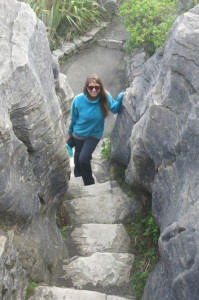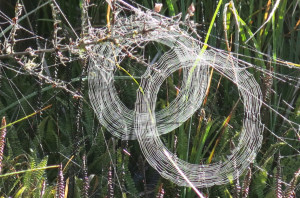Seaside Riding Down the West Coast
by Dave
February 26 – 28
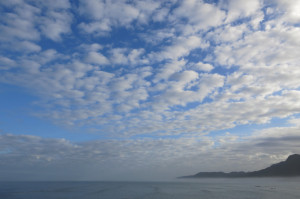 After a restless night of sleep spent spooning with the most annoying sonsabitches we’ve encountered since some of the street vendors in Saigon sand flies, we rose early, making haste and driving like we stole it to get to the coast. Weaving our way through gold country, this was the most remote of regions we had encountered in New Zealand. The West Coast (or Westland, as it’s sometimes referred to) is inhabited by only the heartiest of souls drawn by the mild climate and the isolated lifestyle the area affords them. Like the wild west of old, this region was full of boomtowns during the gold rush of the 1860s, welcoming with open arms some endless waves of Kiwis looking for their big break. Things have quieted down significantly since then in this area, where only about 1% of New Zealand’s population calls the region that takes up 9% of the country’s area home.
After a restless night of sleep spent spooning with the most annoying sonsabitches we’ve encountered since some of the street vendors in Saigon sand flies, we rose early, making haste and driving like we stole it to get to the coast. Weaving our way through gold country, this was the most remote of regions we had encountered in New Zealand. The West Coast (or Westland, as it’s sometimes referred to) is inhabited by only the heartiest of souls drawn by the mild climate and the isolated lifestyle the area affords them. Like the wild west of old, this region was full of boomtowns during the gold rush of the 1860s, welcoming with open arms some endless waves of Kiwis looking for their big break. Things have quieted down significantly since then in this area, where only about 1% of New Zealand’s population calls the region that takes up 9% of the country’s area home.
Now that you’re armed with history and context, let’s get to the good stuff. We covered a lot of ground in a few quick days, so instead of boring you with all the step-by-step details of our journey, Imma give you a sixer of some of the best of the West:
1. Pancake Rocks at Punakaiki – Fittingly, we stopped at that firmly-on-the-beaten-track destination right around breakfast. By happenstance, we beat some of the tour buses and arrived right at high tide. The dramatic sights and booming sounds were humbling (Mama Naytch at work yet again). The rock formation earned its memorable moniker through a long layering-weathering process called “stylobedding.” This caused the limestone to form into what appear to be endless stacks of pancakes. The sea has also eroded a few areas from the base of the rocks, helping form blow holes that, at high tide, put on full display the awesome power of the ocean as waves crash toward shore and erupt through the blowholes like overweight geysers. That’s a long way of saying it was really cool.
2. Greytown and Hokitika – Rolling down the coast, smoking tires, sipping on coffee and water (with my mind on a haircut and a haircut on my mind) we arrived in Greytown. The biggest of the West Coast’s cities, this was most memorable for the fact that I got my first trim in 10 months here. After I lost the locks we only had enough time for a quick tasting at Monteith’s Brewery before carrying on to Hokitika. Aside from being a fun word to say, Hokitika also gave us one of our favorite fish-n-chipses to-date.
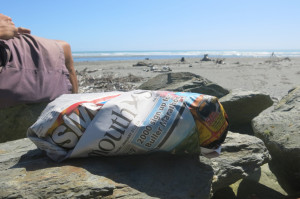
About to tuck into a fish & chips from Dulcie’s on the Quay in Hokitka. The good stuff always comes wrapped in newspaper.
3. Glaciers (or, if you prefer, glay-see-uhhs) – The bulk of the West Coast is bracketed by the Southern Alps to the east and the Tasman Sea to the west, making for some great visual candy in all directions. And soon after the mountains came into view we entered glacier country. Fox and Franz Josef Glaciers are two of the most easily accessible glaciers in the world, both coming into view within a short walk from their respective car parks. We made it to Franz Josef in time to make the 1.5hr walk toward the terminal face of the glacier to catch what we thought would be an up-close view before sundown. When I was in this area in 2007, both glaciers filled the slopes of the southern alps nearly all the way down to the valleys below. Fast forward seven years and the bottom face, or ablution zone (glay-see-uhh terminology, amiright?), of Franz Josef has receded nearly halfway up the mountain, to the point where guided hikes need to be helicoptered onto the glacier since hiking up from the bottom has become too dangerous. Alas, our viewpoint photos would have to suffice.

Sampling some of our favorites from the recent stop in Blenheim. Noelle is smiling through internal outrage caused by losing to me in our blind taste test. To be fair, I only guessed one right. But if you ain’t first, you’re last. (EDITOR’S NOTE: I call a rematch! Going second, I’m pretty sure the sediment left in the glass from Dave’s tasting interfered from my palate’s ability to detect the proper tannins. YES! That’s it! I WIN! I WIN!)
4. Lake Matheson – Having gotten our glacier fix with Franz Josef, we opted for another hike near Fox Glacier that didn’t involve a close-up view of the ice formation. A short drive from our campground, the path to Lake Matheson awaited and was kind enough to play nice and provide the postcard-perfect views we had hoped for. The lake is often referred to as a “mirror lake” because of the water’s smooth-as-glass surface creating a perfect reflection of whatever is off in the distance. The thing that sets Matheson apart from others like it is its “off in the distance” view is of none other than New Zealand’s two highest peaks, Mt. Cook and Mt. Tasman. The views through the forest and out onto the misty morning water throughout the walk are idyllic if you catch it on the type of day we did, but the fact that the two main lookout points are named “Reflection Island” and “View of Views” tells you all you need to know about the main attractions.
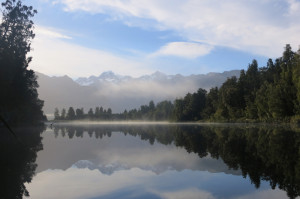
(EDITOR’S NOTE: My editing job was particularly edifying this go round as I reduced the number of photos he included by almost 3/4. You’re welcome, readers)
5. Wanaka views and beers – While this isn’t technically part of the West Coast, there’s a very good reason for it to be included in this post. We just kinda decided to add it here (good enough a reason as any, no?). In any case, Wanaka provided an easy stopover en route to our next destination, Queenstown. But the sometimes-overlooked city has plenty of reasons to warrant at least an overnight in the area. In many ways it plays the role of the quieter, shy younger sibling to crowded Queenstown. But it’s following suit of older brother with a comparable number of tour companies and outdoor adventure opportunities right in its own backyard. We stayed for one night only, before making haste (so much haste in these parts), for Queenstown. But before getting back on the road we stopped in at Wanaka Beerworks, a much talked about craft brewery that still is operating on a pretty small scale, but can hold its own against some of the best we had just tasted in Nelson and Wellington. The Apline Miere Dry Golden Ale in particular was a favorite of ours, with surprisingly satisfying notes of orange and honey that typically wouldn’t be our speed.

The finished product. This NZ staple is basically a fried egg patty cooked with Whitebait fish on buttered bread, finished off with a squeeze of lemon.
6. Cardrona Hotel – This gem tied a quaint and cozy bow on this leg of the south island for us. Completely by chance, the Wanaka Beerworks bartender gave us one of the best recommendations we received in the entire month in New Zealand. On her advice, we zigzagged our way through 70kms of mountain views, following the Crown Range Road en route to Queenstown. Aside from the tussock grass fields, rolling hills and snowcapped mountains along the ride, it also sports a hotel bar and restaurant that has barely changed – for good reason – since it opened its doors 150 years ago. The roaring fire in the dining room at the Cardrona Hotel provided a welcome respite from the cold wind and rain so we tucked into a bowl of seafood chowder and a beer on a comfy fireside couch.

Who knew that a bowl of seafood chowder and a cold beer was all it would take to bring back the blue skies?
Recharged and ready to go, we walked back to the van to find that the sun had come out and lit up the peaks atop the hills in every direction. And with that, we were off to Queenstown.







